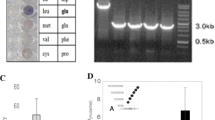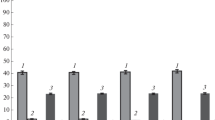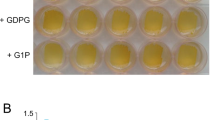Abstract
The NAD+-dependent glyceraldehyde-3-phosphate-dehydrogenase (NAD+-GAPDH) is a key enzyme to sustain the glycolytic function in Escherichia coli and to generate NADH. In the absence of NAD+-GAPDH activity, the glycolytic function can be restored through NADP+-dependent GAPDH heterologous expression. Here, some metabolic and transcriptional effects are described when the NAD+-GAPDH gene from E. coli (gapA) is replaced with the NADP+-GAPDH gene from Streptococcus mutans (gapN). Expression of gapN was controlled by the native gapA promoter (E. coliΔgapA::gapN) or by the constitutive trc promoter in a multicopy plasmid (E. coliΔgapA::gapN/pTrcgapN). The specific NADP+-GAPDH activity was 4.7 times higher in E. coliΔgapA::gapN/pTrcgapN than E. coliΔgapA::gapN. Growth, glucose consumption and acetic acid production rates increased in agreement with the NADP+-GAPDH activity level. Analysis of E. coliΔgapA::gapN/pTrcgapN showed that although gapN expression complemented NAD+-GAPDH activity, the resulting low NADH levels decreased the expression of the respiratory chain and oxidative phosphorylation genes (ndh, cydA, cyoB and atpA). In comparison with the wild type strain, E. coliΔgapA::gapN/pTrcgapN decreased the percentage of mole of oxygen consumed per mole of glucose metabolized by 40 % with a concomitant reduction of 54 % in the ATP/ADP ratio. The cellular response to avoid NADPH excess led to the overexpression of the transhydrogenase coded by udhA and the down-regulation of the pentose-phosphate and Krebs cycle genes, which reduced the CO2 production and increased the acetic acid synthesis. The E. coli strains obtained in this work can be useful for future metabolic engineering efforts aiming for the production of metabolites which biosynthesis depends on NADPH.



Similar content being viewed by others
References
Aguilar C, Escalante A, Flores N et al (2012) Genetic changes during a laboratory adaptive evolution process that allowed fast growth in glucose to an Escherichia coli strain lacking the major glucose transport system. BMC Genom 13:385
Amann E, Ochs B, Abel K (1988) Tightly regulated tac promoter vectors useful for the expression of unfused and fused proteins in Escherichia coli. Gene 69:301–315
Andersen KB, von Meyenburg K (1980) Are growth rates of Escherichia coli in batch cultures limited by respiration? J Bacteriol 144:114–123
Baba T, Ara T, Hasegawa M et al (2006) Construction of Escherichia coli K-12 in-frame, single-gene knockout mutants: the Keio collection. Mol Syst Biol 2:2006.0008
Bergmeyer H (1985) Methods of enzymatic analysis, 3rd edn. VCH Verlagsgesellschaft mbH, Weinheim
Bogaerts J, Zoske S, Weidner U, Linden G (1995) Transcriptional regulation of the proton translocating NADH dehydrogenase (nuoA-N) of Escherichia coli by electron acceptors, electron donors and gene regulators. Mol Microbiol 16:521–534
Boyd DA, Cvitkovitch DG, Hamilton IANR (1995) Sequence, expression, and function of the gene for the phosphate dehydrogenase of Streptococcus mutans. J Bacteriol 177:2622–2627
Bradford M (1976) A rapid and sensitive method for the quantitation of microgram quantities of protein utilizing the principle of protein-dye binding. Anal Biochem 72:248–254
Brandsch R (1989) Covalent cofactor binding to flavoenzymes requires specific effectors. Eur J Biochem 182:125–128
Brown AT, Wittenberger CL (1971) Mechanism for regulating the distribution of glucose carbon between the Embden-Meyerhof and hexose-monophosphate pathways in Streptococcus faecalis. J Bacteriol 106:456–467
Bustin SA, Benes V, Garson JA et al (2009) The MIQE guidelines: minimum information for publication of quantitative real-time PCR experiments. Clin Chem 55:611–622
Canonaco F, Hess TA, Heri S et al (2001) Metabolic flux response to phosphoglucose isomerase knock-out in Escherichia coli and impact of overexpression of the soluble transhydrogenase UdhA. FEMS Microbiol Lett 204:247–252
Chang ACY, Cohen SN (1978) Construction and characterization of amplifiable multicopy DNA cloning vehicles derived from the P15A cryptic miniplasmid. J Bacteriol 134:1141–1156
Charpentier B, Branlant C (1994) The Escherichia coli gapA gene is transcribed by the vegetative RNA polymerase holoenzyme Eσ70 and by the heat shock RNA polymerase Eσ32. J Bacteriol 176:830–839
Charusanti P, Conrad TM, Knight EM et al (2010) Genetic basis of growth adaptation of Escherichia coli after deletion of pgi, a major metabolic gene. PLoS Genet 6(11):e1001186
Chávez-Béjar M, Lara AR, López H et al (2008) Metabolic engineering of Escherichia coli for L -tyrosine production by expression of genes coding for the chorismate mutase domain of the native chorismate mutase-prephenate dehydratase and a cyclohexadienyl dehydrogenase from Zymomonas mobilis. Appl Environ Microbiol 74:3284–3290
Cherepanov PP, Wackernagel W (1995) Gene disruption in Escherichia coli: TcR and KmR cassettes with the option of Flp-catalyzed excision of the antibiotic-resistance determinant. Gene 158:9–14
Cho H-S, Seo SW, Kim YM et al (2012) Engineering glyceraldehyde-3-phosphate dehydrogenase for switching control of glycolysis in Escherichia coli. Biotechnol Bioeng 109:2612–2619
Crow L, Wittenbergerg CL (1979) Separation and properties of NAD+- and NADP+-dependent glyceraldehyde-3-phosphate dehydrogenases from Streptococcus mutans. J Biol Chem 254:1134–1142
Csonka LN, Fraenkel DG (1977) Pathways of NADPH formation in Escherichia coli. J Biol Chem 252:3382–3391
D′Alessio G, Josse J (1971) Glyceraldehyde phosphate dehydrogenase of Escherichia coli. J Biol Chem 246:4326–4333
Datsenko K, Wanner BL (2000) One-step inactivation of chromosomal genes in Escherichia coli K-12 using PCR products. Proc Natl Acad Sci USA 97:6640–6645
Dittrich CR, Vadali RV, Bennett GN, San K (2005) Redistribution of metabolic fluxes in the central aerobic metabolic pathway of E. coli mutant strains with deletion of the ackA-pta and poxB pathways for the synthesis of isoamyl acetate. Biotechnol Prog 21:627–631
Fillinger S, Boschi-Muller S, Azza S et al (2000) Two glyceraldehyde-3-phosphate dehydrogenases with opposite physiological roles in a nonphotosynthetic bacterium. J Biol Chem 275:14031–14037
Flores N, Flores S, Escalante A et al (2005) Adaptation for fast growth on glucose by differential expression of central carbon metabolism and gal regulon genes in an Escherichia coli strain lacking the phosphoenolpyruvate:carbohydrate phosphotransferase system. Metab Eng 7:70–87
Foster JW, Park YK, Penfound T et al (1990) Regulation of NAD metabolism in Salmonella typhimurium: molecular sequence analysis of the bifunctional nadR regulator and the nadA-pnuC operon. J Bacteriol 172:4187–4196
Fuhrer T, Sauer U (2009) Different biochemical mechanisms ensure network-wide balancing of reducing equivalents in microbial metabolism. J Bacteriol 191:2112–2121
Habenicht A (1997) The non-phosphorylating glyceraldehyde-3-phosphate dehydrogenase: biochemistry, structure, occurrence and evolution. Biol Chem 378:1413–1419
Hillman JD, Fraenkel DG (1975) Glyceraldehyde 3-phosphate dehydrogenase mutants of Escherichia coli. J Bacteriol 122:1175–1179
Hollywood N, Doelle H (1976) Effect of specific growth rate and glucose concentration on growth and glucose metabolism of Escherichia coli K-12. Microbios 17:23–33
Holm AK, Blank LM, Oldiges M et al (2010) Metabolic and transcriptional response to cofactor perturbations in Escherichia coli. J Biol Chem 285:17498–17506
Iddar A, Valverde F, Serrano A, Soukri A (2002) Expression, purification, and characterization of recombinant nonphosphorylating NAP-dependent glycerladehyde-3-phosphate dehydrogenase from Clostridium acetobutylicum. Protein Expr Purif 25:519–526
Iddar A, Valverde F, Serrano A, Soukri A (2003) Purification of recombinant non-phosphorylating NADP-dependent glyceraldehyde-3-phosphate dehydrogenase from Streptococcus pyogenes expressed in E. coli. Mol Cell Biochem 247:195–203
Iddar A, Valverde F, Assobhei O et al (2005) Widespread occurrence of non-phosphorylating dehydrogenase among Gram-positive bacteria. Int Microbiol 8:251–258
Irani MH, Maitra PK (1977) Properties of Escherichia coli mutants deficient in enzymes of glycolysis. J Bacteriol 132:398–410
Jensen PR, Michelsen OLE (1992) Carbon and energy metabolism of atp mutants of Escherichia coli. J Bacteriol 174:7635–7641
Kabir MM, Shimizu K (2003) Fermentation characteristics and protein expression patterns in a recombinant Escherichia coli mutant lacking phosphoglucose isomerase for poly(3-hydroxybutyrate) production. Appl Environ Microbiol 62:244–255
Kalman LV, Gunsalus RP (1988) The frdR Gene of Escherichia coli globally regulates several operons involved in anaerobic growth in response to nitrate. J Bacteriol 170:623–629
Kern A, Tilley E, Hunter IS et al (2007) Engineering primary metabolic pathways of industrial micro-organisms. J Biotechnol 129:6–29
Kim S, Moon D-B, Lee C-H et al (2009) Comparison of the effects of NADH- and NADPH-perturbation stresses on the growth of Escherichia coli. Curr Microbiol 58:159–163
Kim S, Lee CH, Nam SW, Kim P (2011) Alteration of reducing powers in an isogenic phosphoglucose isomerase (pgi)-disrupted Escherichia coli expressing NAD(P)-dependent malic enzymes and NADP-dependent glyceraldehyde 3-phosphate dehydrogenase. Lett Appl Microbiol 52:433–440
Kocharin K, Siewers V, Nielsen J (2013) Improved polyhydroxybutyrate production by Saccharomyces cerevisiae through the use of the phosphoketolase pathway. Biotechnol Bioeng 110:2216–2224
Koebmann BJ, Westerhoff HV, Snoep JL et al (2002) The glycolytic flux in Escherichia coli is controlled by the demand for ATP. J Bacteriol 184:3909–3916
Lee HC, Kim JS, Jang W, Kim SY (2010) High NADPH/NADP+ ratio improves thymidine production by a metabolically engineered Escherichia coli strain. J Biotechnol 149:24–32
Livak KJ, Schmittgen TD (2001) Analysis of relative gene expression data using real-time quantitative PCR and the 2(−Delta Delta C(T)) method. Methods 25:402–408
Marchal S, Branlant G (2002) Characterization of the amino acids involved in substrate specificity of nonphosphorylating glyceraldehyde-3-phosphate dehydrogenase from Streptococcus mutans. J Biol Chem 277:39235–39242
Martínez I, Zhu J, Lin H et al (2008) Replacing Escherichia coli NAD-dependent glyceraldehyde 3-phosphate dehydrogenase (GAPDH) with a NADP-dependent enzyme from Clostridium acetobutylicum facilitates NADPH dependent pathways. Metab Eng 10:352–359
Moat AG, Foster JW, Spector MP (2002) Fermentation pathways. Microbial Physiology p 412–433
Noda S, Takezawa Y, Mizutani T et al (2006) Alterations of cellular physiology in Escherichia coli in response to oxidative phosphorylation impaired by defective F1-ATPase. J Bacteriol 188:6869–6876
Phue J-N, Lee SJ, Kaufman JB et al (2010) Acetate accumulation through alternative metabolic pathways in ackA − pta − poxB − triple mutant in E. coli B (BL21). Biotechnol Lett 32:1897–1903
Sambrook J, Rusell D (2001) Molecular cloning a laboratory manual, 3rd edn. Cold Spring Harbor Laboratory Press, Cold Spring Harbor
Sauer U, Canonaco F, Heri S et al (2004) The soluble and membrane-bound transhydrogenases UdhA and PntAB have divergent functions in NADPH metabolism of Escherichia coli. J Biol Chem 279:6613–6619
Sigala JC, Flores S, Flores N et al (2009) Acetate metabolism in Escherichia coli strains lacking phosphoenolpyruvate: carbohydrate phosphotransferase system; evidence of carbon recycling strategies and futile cycles. J Mol Microbiol Biotechnol 16:224–235
Takahashi H, Inada T, Postma P, Aiba H (1998) CRP down-regulates adenylate cyclase activity by reducing the level of phosphorylated IIA(Glc), the glucose-specific phosphotransferase protein, in Escherichia coli. Mol Gen Genet 259:317–326
Takeno S, Murata R, Kobayashi R et al (2010) Engineering of Corynebacterium glutamicum with an NADPH-generating glycolytic pathway for l-lysine production. Appl Environ Microbiol 76:7154–7160
Taylor S, Wakem M, Dijkman G et al (2010) A practical approach to RT-qPCR-publishing data that conform to the MIQE guidelines. Methods 50:S1–S5
Thouvenot B, Charpentier B, Branlant C (2004) The strong efficiency of the Escherichia coli gapA P1 promoter depends on a complex combination of functional determinants. Biochem J 382:371–382
Valverde F, Losada M, Serrano A (1999) Engineering a central metabolic pathway: glycolysis with no net phosphorylation in an Escherichia coli gap mutant complemented with a plant gapN gene. FEBS Lett 449:153–158
Vemuri GN, Altman E, Sangurdekar DP et al (2006) Overflow metabolism in Escherichia coli during steady-state growth: transcriptional regulation and effect of the redox ratio. Appl Environ Microbiol 72:3653–3661
Waegeman H, De Lausnay S, Beauprez J et al (2013) Increasing recombinant protein production in Escherichia coli K12 through metabolic engineering. N Biotechnol 30:255–261
Yagi T, Matsuno-yagi A (2003) The proton-translocating NADH-quinone oxidoreductase in the respiratory chain: the secret unlocked. Biochemistry 42:2266–2274
Acknowledgments
We gratefully acknowledge Georgina Hernández-Chávez, Luz María Martínez, Mercedes Enzaldo, Ramón de Anda and Adelfo Escalante for technical assistance. We thank Martha Giles (Facultad de Química—Universidad Nacional Autónoma de México) for providing the Streptococcus mutans strain. This work was supported by the Mexican Council of Science and Technology (CONACyT). SC-L held a scholarship from CONACyT.
Author information
Authors and Affiliations
Corresponding author
Rights and permissions
About this article
Cite this article
Centeno-Leija, S., Utrilla, J., Flores, N. et al. Metabolic and transcriptional response of Escherichia coli with a NADP+-dependent glyceraldehyde 3-phosphate dehydrogenase from Streptococcus mutans . Antonie van Leeuwenhoek 104, 913–924 (2013). https://doi.org/10.1007/s10482-013-0010-6
Received:
Accepted:
Published:
Issue Date:
DOI: https://doi.org/10.1007/s10482-013-0010-6




